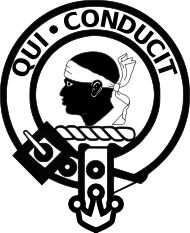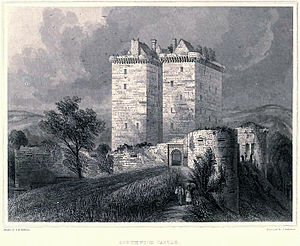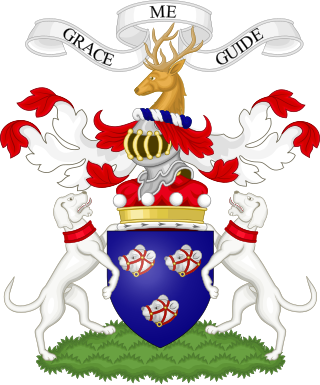| Clan Borthwick | |
|---|---|
 Crest: A moor's head couped Proper wreathed Argent and Sable | |
| Motto | Qui conducit ("He Who Leads") |
| Chief | |
 | |
| John Hugh Borthwick of that Ilk | |
| 24th Lord Borthwick | |
| Historic seat | Borthwick Castle |
Clan Borthwick is a Scottish clan. [1]
| Clan Borthwick | |
|---|---|
 Crest: A moor's head couped Proper wreathed Argent and Sable | |
| Motto | Qui conducit ("He Who Leads") |
| Chief | |
 | |
| John Hugh Borthwick of that Ilk | |
| 24th Lord Borthwick | |
| Historic seat | Borthwick Castle |
Clan Borthwick is a Scottish clan. [1]
The name Borthwick is of territorial origin. [1] It is a traditional origin that the progenitor of Clan Borthwick was Andreas, a Livonian knight who accompanied the Saxon Edgar the Ætheling and his sister, Margaret, who was later queen and saint, to Scotland in 1067. [1] However recent research has suggested that the Borthwicks may have come to Scotland with Julius Caesar's Roman legions. [1]
Sir William Borthwick held substantial lands in Midlothian and the Scottish Borders and obtained a charter confirming the lands of Borthwick in about 1410. [1] It is after these lands that the family was named. [1] Also during the 15th century the Borthwicks became Lords of the Parliament of Scotland. [1]
William Borthwick, 1st Lord Borthwick was one of the nobles who was sent as substitute hostages for the ransom of James I of Scotland in 1425. [1] He was responsible for the construction of what is now one of the most impressive fortified dwellings in Scotland, Borthwick Castle, which remains in the ownership of the Borthwick family. [1] The first Lord Borthwick died before 1458 and is commemorated in a splendid tomb in the old Borthwick church. [1] The church is now in private hands.
During the Anglo-Scottish Wars the Borthwicks fought on the side of King James IV of Scotland at the Battle of Flodden in 1513. [1] William Borthwick, 4th Lord Borthwick, whose father had died in the previous decade, was given command of Stirling Castle and charged with the safety of the infant James V of Scotland. [1]
John, Lord Borthwick was an opponent of the Reformation of the Church of Scotland and a supporter of Mary of Guise. [1] His adherence to the church, however, did not mean he was in favour with the church hierarchy and in 1547 he was excommunicated for contempt of the Ecclesiastical Court of the See of St Andrews. [1] An officer of the court, William Langlands, was dispatched to deliver the letters of excommunication to the curate of Borthwick. [1] Langlands was seized by Borthwick's men and thrown in the mill dam north of the castle. [1] Later they made him eat the letters, having first soaked them in wine. [1] He was sent back with the warning that any other letters would 'a gang the same gait'. [1]
John's son, William, was a close friend and confidant of Mary, Queen of Scots. [1] Mary took refuge with her husband, James Hepburn, 4th Earl of Bothwell, but was forced to flee when a force under James Stewart, Earl of Moray approached. [1] She is said to have escaped dressed as a page. [1]
In 1573, David Borthwick of Lochhill became the king's advocate or principal legal adviser. [1] However, not all Borthwicks were nobles. [1] Robert Borthwick was the Master Gunner to James IV of Scotland in 1509 and is said to have cast seven great cannons which were called the Seven Sisters. [1]
During the Wars of the Three Kingdoms the Borthwicks supported the royalist cause and their castle was besieged after the Battle of Dunbar (1650). [1] The east wall of the castle was blasted with cannon fire from a nearby hillside. Damage was done to the outer wall (still visible to this day), but, before the wall was breached, the inhabitants of the castle surrendered to Oliver Cromwell's forces. The fortress was spared destruction when Cromwell offered Lord Borthwick terms of surrender which he accepted. [1]
In 1762 Henry Borthwick of Neathorn was recognised as male heir first Lord by the House of Lords. [1] However although he assumed the title he died without heirs ten years later. [1] During the 18th century and 19th century various branches of the family disputed the line of succession until in 1986, Major John Borthwick of Crookston was recognised by the Lord Lyon, King of Arms as Borthwick of that Ilk, chief of the name and arms of Borthwick. [1] He also became the 23rd Lord Borthwick in the Peerage of Scotland. His son John Hugh Borthwick became the 24th Lord Borthwick three months prior to his death.[ citation needed ]

The seat of the chief of Clan Borthwick has always been at Borthwick Castle. [1]
John Hugh Borthwick of that Ilk, 24th Lord Borthwick, Chief of the Name and Arms of Borthwick, 18th of Crookston, Baron of Heriotmuir. [2]

Clan Robertson, also known as Clan Duncan is a Scottish clan.

Earl of Home is a title in the Peerage of Scotland. It was created in 1605 for Alexander Home of that Ilk, 6th Lord Home. The Earl of Home holds, among others, the subsidiary titles of Lord Home and Lord Dunglass (1605) in the Peerage of Scotland, and Baron Douglas, of Douglas in the County of Lanark (1875), in the Peerage of the United Kingdom. Various Earls of Home have also claimed the title of Lord Hume of Berwick. The Earl is also Chief of the Name and Arms of Home and heir general to the House of Douglas. The title of Lord Dunglass is used as a courtesy title by the eldest son of the Earl.

Earl of Airlie is a title of the peerage in Scotland created on 2 April 1639 for James Ogilvy, 7th Lord Ogilvy of Airlie, along with the title "Lord Ogilvy of Alith and Lintrathen". The title "Lord Ogilvy of Airlie" was created on 28 April 1491.

Lord Borthwick is a title in the Peerage of Scotland.

Clan MacDonell of Glengarry, also known as Clan Ranald of Knoydart & Glengarry is a Scottish clan and is a branch of the larger Clan Donald. The clan takes its name from River Garry where the river Garry runs eastwards through Loch Garry to join the Great Glen about 16 miles (25 km) north of Fort William, Highland. The progenitor of the MacDonells of Glengarry is Reginald, 4th great-grandson of the warrior Somerled. The clan chief is traditionally designated as the "Son of Alexander's son".

Clan Brodie is a Scottish clan whose origins are uncertain. The first known Brodie chiefs were the Thanes of Brodie and Dyke in Morayshire. The Brodies were present in several clan conflicts, and during the civil war were ardent covenanters. They resisted involvement in the Jacobite uprisings, and the chief's family later prospered under the British Empire in colonial India.

Clan Sinclair is a Highland Scottish clan which holds the lands of Caithness, the Orkney Islands, and the Lothians. The chiefs of the clan were the Barons of Roslin and later the Earls of Orkney and Earls of Caithness.

Clan Drummond is a Highland Scottish clan. The surname is rendered "Druimeanach" in modern Scottish Gaelic.

The Clan MacLellan is a Scottish clan of the Scottish Lowlands. The clan does not currently have a chief therefore it is considered an Armigerous clan.

Clan Cranstoun is a family of the Scottish Lowlands.

Clan Dewar is a Scottish clan.

Clan Home is a Scottish clan. It held immense power for much of the Middle Ages and dominated the eastern Scottish Borders. It produced no fewer than eight Wardens of the Eastern March – more than any other family.

Clan Sempill is a Scottish clan of the Scottish Lowlands.

The Forresters are an ancient and noble clan of the Scottish Lowlands.

Clan Oliphant is a Highland Scottish clan.

Clan Leask is a Scottish clan.

Clan Swinton is a Scottish clan of the Scottish Lowlands.

Sir William Borthwick, 3rd of Borthwick and later 1st Lord Borthwick was a Scottish peer and ambassador.

Clan Stuart of Bute is a Highland Scottish Clan and is a branch of the larger Clan Stewart.

Clan Forbes is a Highland Scottish clan from Aberdeenshire, Scotland.